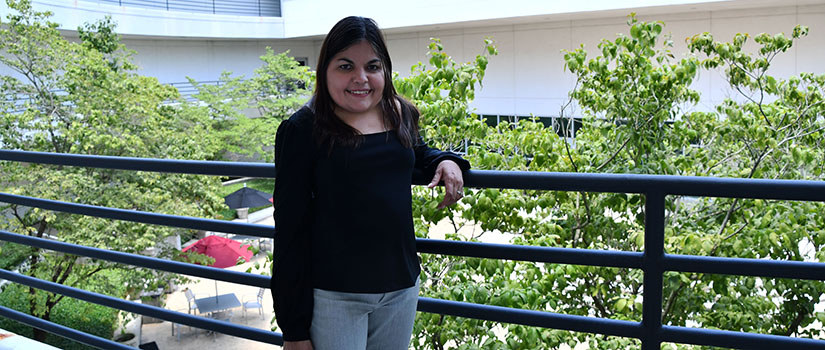How one summer at USC changed chemical engineering instructor Ivelisse Ortiz-Hernandez’s future.
In the summer of 1998, the University of South Carolina Board of Trustees approved the construction of the $38.6 million Strom Thurmond Wellness and Fitness Center, and the Columbia Museum of Art opened. That same summer, Ivelisse Ortiz-Hernandez arrived on the USC campus for the first time.
She was a chemical engineering student from the University of Puerto Rico and came to Columbia after being selected for the National Science Foundation’s (NSF) Summer Research Experience for Undergraduates (REU) program in chemical engineering. It was an experience that not only played a part in changing her future but also eventually led her back to the university as a graduate student and instructor.
Once on campus for the NSF REU in 1998, her advisor was then-chemical engineering professor and current USC President Michael Amiridis. Two years later in the spring of 2000, Ortiz-Hernandez was preparing to graduate. She planned to work in the fine chemical industry and graduate school was not part of her plans. That changed when Amiridis called and left a message. When she called back, he asked her if she was interested in returning to USC to earn her Ph.D. and be a graduate research assistant as part of his catalysis research team.
“When I called him back, he said, 'Do you want to come and work for me? Take the GRE, fill out the application, do everything else and you're in.’ I did everything he asked me to, and I was here by August,” Ortiz-Hernandez says.
Ortiz-Hernandez eventually worked with Chemical Engineering Professor Christopher Williams, who was a new faculty member at the time and worked closely with Amiridis. He also served as the head of Ortiz-Hernandez’s Ph.D. committee.
“As a young professor starting out at USC, it is critical to have creative, dedicated and productive graduate students who take ownership of their research project. Ivelisse was all these things while we pioneered a new research approach in our field to examine catalysis at solid-liquid interfaces,” Williams says.
After earning her Ph.D., Ortiz-Hernandez began her teaching career as an instructor and academic program director for chemical technology at Midlands Technical College in Columbia. In addition to her recruiting responsibilities, she taught at least four classes a semester, including engineering chemistry and thermodynamics.
“I didn't mind working at Midlands Tech. I liked the job, and it was rewarding to build a new program, but it was a lot of work and time consuming. With young kids, it was hard to balance,” Ortiz-Hernandez says.
Ortiz-Hernandez was at Midlands Tech for 11 years before returning to USC for a second time. Nearly 20 years after first stepping foot on campus, she began her current position as a chemical engineering instructor in 2017.
She always advises and encourages students to gain outside experiences, such as internships and research. As someone who benefitted greatly from such experiences as an undergraduate and graduate student, she impresses upon students how these activities prepare them for their professional career.
- Christopher Williams
Ortiz-Hernandez says she has seen many instances where students question themselves in the classroom. But she considers herself to be a positive influence to help them become successful without allowing doubts to impact their outcomes.
“It's not always easy to be approachable, so one of my teaching philosophies is to make myself available when students have questions or troubles related to the class or anything in general,” Ortiz-Hernandez says. “There’s a good working environment in the classroom where students are happy to participate and not afraid to ask questions.”
Ortiz-Hernandez currently teaches introduction to chemical engineering, introduction to chemical engineering thermodynamics, heat flow analysis and chemical process safety as well as a chemical process principles class in the summer. She is also a major part of retention in the Department of Chemical Engineering to keep students engaged while identifying any issues as early as possible.
“When students take early courses in the curriculum with me, I re-advise them to ensure that they take courses in the correct order, so they don’t end up with an excessive workload. They can easily burn themselves out if they take too many chemical engineering classes. By the time they take my thermodynamics class, I can tell if they can handle it,” Ortiz-Hernandez says. “I give them advice on which classes are best to combine and the order that they should take them.”
Ortiz-Hernandez also serves as the advisor for the USC chapter of the Society of Hispanic Professional Engineers. The organization’s goal is to empower the Hispanic community and impact the world through STEM awareness, access, support and development.
“It’s nice for Latinos to have a community within the college so they can interact and not feel isolated. The group was almost dead by the time that I got involved with the chapter, and part of the success was getting a few people that were excited to run it, and it seems like it's growing,” Ortiz-Hernandez says.
Ortiz-Hernandez has seen the College of Engineering and Computing from three different perspectives: a summer research program participant, graduate student and instructor. And she continues to impart her more than 25 years’ experience in academia and research to her students, while reminding them to be life-long learners.
“I usually emphasize that students need to be humble because as engineers, we have a tendency to think that we know better than everyone. But you can’t do that working in industry,” Ortiz-Hernandez says. “Being humble can go a long way and willing to learn from others and adapt is very important.”
